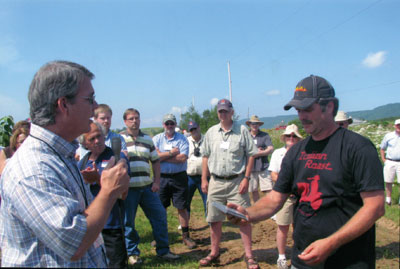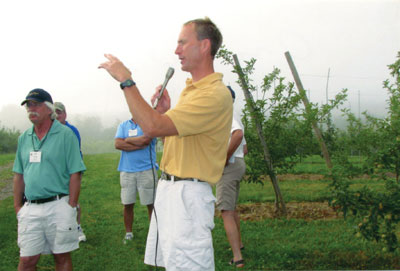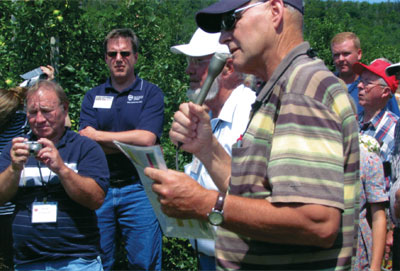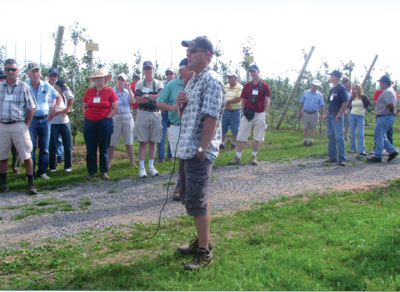
Features
Production
Research
Apple producers from around the world tour Nova Scotia
December 2, 2009 By Dan Woolley
Nova Scotia fruit operations were in the spotlight this past summer when the International Fruit Tree Association held its summer tour in the Annapolis Valley.
Nova Scotia fruit operations were in the spotlight this past summer when the International Fruit Tree Association held its summer tour in the Annapolis Valley.
About 115 delegates from the annual event participated in the three-day tour.
They stopped, initially, at Jonathan Fuller’s extensively revised orchard at Avonport, N.S. Fuller phased out his family farm’s beef herd and strawberry you-pick after he took over in 1988 and expanded its 35 acres of apples to its present 75 acres.
 |
|
| Neal Manley (left), past president of the International Fruit Tree Association, presents Blake Sarsfield (right) with a commemorative plaque during a tour of his operation. |
|
 |
|
| Jonathan Fuller describes how he has renovated his orchard at Avonport, N.S. |
|
 |
|
| John Eisses describes how his orchard management has changed over the years. |
|
 |
|
| Gerry Van Oostrum details the changes he has made to his family’s orchard at Canard since he took over the operation in 2000. (Photos by Dan Woolley)
|
Today, he has just three rows remaining of Empire from the old orchard. “Once I started cutting, I couldn’t turn off the chainsaw,” Fuller said.
He put Honeycrisp, Red Cortland, Red Delicious and Northern Spy in high-density plantings. First, he planted Honeycrisp on M26 rootstock at a spacing of eight feet by 16 feet on stakes. Switching eventually to MM111 roostock for an additional planting of Honeycrisp and Red Cortland.
Fuller later switched back to M26 for another Honeycrisp block at a six-foot by 16-foot spacing supported by a single wire conduit. “It makes a nice system,” he said.
But he would not plant Northern Spy again in 16-foot-wide row spacings. “It is too close,” he said.
Deer also destroyed two-thirds of an eight-acre block Fuller had planted. “If you are going to put in deer fencing, put it in before you plant the block,” he said.
As well, Fuller said he would never again plant Jonagold or Russet. “Jonagold is a nice apple but it is hard to get them coloured-up.”
Recently, Fuller has grafted over his Jonagold and Red Delicious plantings to Honeycrisp. “If you are grafting over trees, nothing grafts over better than Honeycrisp,” he said.
Sarsfield Farms
In 1996, Blake Sarsfield became one of the first Nova Scotian growers in the province to plant Honeycrisp and he now has one of Canada’s largest Honeycrisp plantings at Sarsfield Farms in Medford, N.S.
Over the seasons, he has tried M4, M7, M9, M26, MM111 and CG30 rootstocks with much of his planting done in co-operation with Scotian Gold Cooperative and its vice president of agricultural services, Larry Lutz.
After visiting Washington state in 1996, Sarsfield adopted a V-trellis suspension system, replacing wooden stakes. In 1998, he installed conduit suspension for a Honeycrisp block and he has decided he will never build another trellis.
Honeycrisp dominate his 270 acres of orchard, which also has the province’s largest Nova Spy planting, plus some Gala, Ginger Gold, Ambrosia and Red Delicious.
Sarsfield was the first Annapolis Valley grower to use global positioning in 2007 for precision planting. Now he uses the technology to determine his fumigation strips, which has enabled him to reduce the strips from 6.5 feet wide to 4.5 feet. “You are basically saving about one-third of your fumigation product,” he said.
Extensive plantings
At Centreville, N.S., John Eisses has expanded and replanted much of his 110-acre apple orchard over the last 15 years. Currently, about 45 per cent of the plantings are on semi-dwarf rootstocks with the rest on dwarf.
Besides being one of Canada’s largest Honeycrisp producers, Eisses also has extensive plantings of Ambrosia, Nova Spy, Northern Spy, Jonagold and Jubilee Fuji.
“He invests what it takes to grow an orchard,” said Larry Lutz, IFTA’s current president. “He gets 2,000 bushels an acre when others get 400 bushels an acre.”
According to Eisses, spur pruning has made a dramatic difference in his Honeycrisp orchard, doubling his production from under 650 bushels per acre to more than 1,300 bushels.
During the past seven years, his Golden Delicious production has ranged between 650 and 1,700 bushels per acre, with his Northern Spy harvest ranging between 700 and 2,300 bushels an acre.
Advice from a soil scientist and consultant on fertility management combined with orchard fumigation has also made a big difference in his orchards’ productivity, Eisses noted.
Leading high density
Gerry Van Oostrum’s orchard in Canard, N.S., is seen as a leader in new, high density orchard planting, following a model set by his father, from whom he took over nine years ago.
Almost all of Van Oostrum’s planting occurs on M9 rootstock, which performs very well in his orchard soil. His main varieties are McIntosh, Pacific and Royal Galas, Honeycrisp, Jonagold, Red Cortland, as well as Ambrosia and Red Delicious.
In his first planting, Van Oostrum grafted Honeycrisp to EM26. He estimates he will get about 50 bins to an acre from his Honeycrisp and is hoping to achieve a 90 per cent pack out.
The vigour of Honeycrisp on EM26 has surprised Van Oostrum, who intensively pruned its dormant wood, “cutting off as many buds as we can from the start.”
He also uses various training and support systems, including super spindle and slender spindle.
International Fruit Tree Association delegates from throughout the United States and Canada took part in the Nova Scotia orchard tour, including a few from New Zealand and the United Kingdom.
“The people from away were pretty impressed with what they saw,” said Lutz.
Print this page